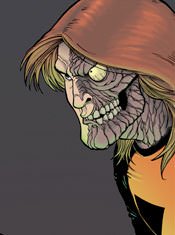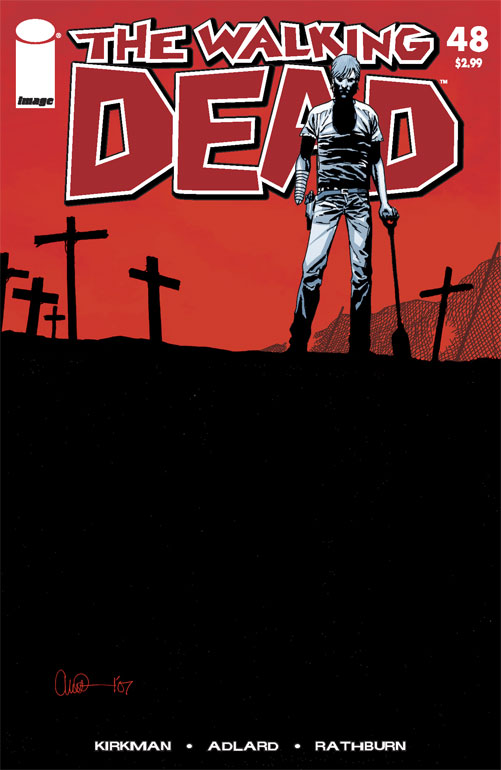Horror in comics weekend
concludes with a brief summary of some other horror titles I have enjoyed. I’m
looking for recommendations of other good horror comics, so any suggestions are
greatly appreciated.
I’d better start with the one
I know best – Halloween Man. For over ten years I’ve been the editor of this
ongoing webcomic, which has just been snapped up by Monsterverse Comics. I
can’t really be impartial about it, but when the first Monsterverse stuff comes
out next year you really should check it out.
A few years ago there was a
run of Halloween books from Devil’s Due comics, written by Stefan Hutchinson.
There was a miniseries (Nightdance), the anniversary book Halloween: 30 Years
of Terror and then another miniseries (The First Death of Laurie Strode) which
aimed to bridge the gap between Halloween II and Halloween H20. Unfortunately,
for awkward and confusing reasons the miniseries was never completed. A quick
search through online retailers or an actual comic book store is worth your
while to track these down, Hutchinson manages to capture something more in line
with the “trilogy” than the other films in the series.
Alan Moore’s Swamp Thing is
still very highly regarded, and with very good reason. The short version is
that Moore took over a lower-tier title, wrote a single issue clearing the
decks and then stripped the character down and rebuilt him from the ground up.
Over the course of 44 issues, Moore pretty much created the blueprint for
modern horror comics – without Swamp Thing, no Hellblazer. Without Hellblazer,
no Sandman. Without Hellblazer and Sandman, no Vertigo.
Before Moore, Swamp Thing was
a title about a scientist named Alec Holland who had been turned into a plant
being through an explosion of comic book science. The overall plot was about
Holland’s quest to regain his humanity. Moore spun that around so that Holland
had died in the explosion, which led to his consciousness being absorbed into a
plant elemental. Knowing he was dead and would never again be human led Holland
to explore his life as a plant elemental and the new abilities that gave him.
Moore’s run deals with
multiple forms of horror. There’s a lot of magic, demonology and possession,
but also vampires, zombies, werewolves, ghosts, radioactive mutants and more. The
key element that raises these stories above the mainstream is how Moore wraps
these stories in real life horror – interweaving them with stories of abused
wives and children, slavery, incest, shootings, alcoholism, environmental
destruction and serial killers until they become one. In clumsier hands these could
have been cliche-filled messes, but Alan Moore’s hands are steady. Forget
Watchmen, this is his best work at DC.
Unsurprisingly, one of the
supporting characters from Moore’s run was given his own book. Unfortunately,
the perfect title had already been taken by a Clive Barker film, and so John
Constantine had to settle for the essentially meaningless Hellblazer.
Constantine was a chain-smoking Liverpudlian con-man, occult detective and
magic user who had appeared in Swamp Thing as something approximating a tour
guide to the dark magical underbelly of America and beyond, with a greater
understanding of who Swamp Thing was than he himself had at the time. His solo
title followed his “adventures” after he returned home.
The book originated under Jamie Delano, but
it’s the work of later writers I want to bring up here. Issues 25 and 26 from
during Delano’s run are a fill-in by Grant Morrison and mix mass insanity,
British cultural tradition and anti-nuclear-weapon concerns to terrifying
effect. This is still one of my favourite Hellblazer stories ever, and
definitely one of the most frightening. After Delano came Garth Ennis, and it’s
his run on the book I followed the most closely.
Ennis told stories of ordinary
horror, giving John lung cancer in his first storyline before mixing the
machinations of heaven and hell with British politics and race relations,
vampirism with homelessness and more. He blended these stories in a completely
different way to Moore, but the effect was the same – the scares came from both
sides of the reality curtain, and merged to become greater than the sum of
their parts.
I really need to explore more
post-Ennis Hellblazer. I’ve picked up the odd collection here and there, but
they’ve never really grabbed me quite the same way.
Neil Gaiman’s Sandman started
out as more of a horror title, before opening out into all aspects of the
fantastic through fairytales, myths and magic and beyond. But the horror never
quite went away, lasting right through to the end.
Sandman, for those who have
never picked up a copy, is about Dream, who is both the lord of dreams and an
anthromporphised personification of dreams, stories and all that is outside of
reality. A very basic summation of the overall plot by Gaiman is "The
Lord of Dreams learns that one must change or die, and makes his
decision."
The purest horror stories
occur in the first two volumes – in the first volume, Preludes and Nocturnes we
have the story 24 Hours, which deals with the gradual mental breakdown of the
population of a diner thanks to the manipulation of an old DC comics supervillain
named Doctor Destiny who stops them from leaving. Supernaturally warped cabin
fever follows, leading to violence, sex and soul-baring. In the end, despite
the outside mystical influence this is just a story about a group of people
going insane.
The other great horror story
from Sandman is called Collectors. If serial killers are your thing, this one
is for you. Under the punning guise of a cereal convention, serial killers from
all across America gather for a convention in a hotel in Georgia. Over the
course of a single issue, Gaiman burns through enough serial killers for a
bookshelf of Thomas Harris imitators and each one is terrifyingly believable.
Then he ends by destroying their mythic power – Dream makes them realise the
truth behind the fictions they have built up in their own minds about them
being mighty hunters and figures of greatness, and they shuffle out, broken.
Finally, we find the biggest
title in American comics at the moment – Robert Kirkman and Charlie Adlard’s zombie
apocalypse epic The Walking Dead. I’m way behind on this one as I’m reading it
in the massive 48 issue compendium editions, and I’ve only finished the first
volume so I’ll keep my thoughts brief.
I gave up on the TV version
quite quickly, but I may have to give it another chance. I’ve enjoyed the comic
book series so far, although it’s incredibly bleak – I’m almost 100 issues in,
and I’m wondering just how Rick hasn’t just snapped and put a gun in his mouth
by now. He meets some new people, a few of them die, a few of his friends die,
and the survivors march on. Repeat to fade.
Even in black and white,
Adlard’s zombies are the equal of anything TV or movies have given us, with
accompanying gore to match. I’m not surprised that this title is a success but
just how much of a success is mind-blowing. This is from a few months ago,
but...
Well, in the full BookScan list, there are forty-two
books listed with "TWD" (including the $100 boxed hardcovers, or the
book of just the covers, and so on), summing up to almost 685k copies all
together -- almost 7% of all comics total sold to BookScan reporters. In
dollars? A staggering $20.5 million dollars, which means that, hang on to your
hats, nearly one dollar of comics in eight that was sold by a BookScan reporter
went to "The Walking Dead." One in eight, that's insane!
What that means is "TWD," all by itself, is
the #3 largest publisher on BookScan. Or, to put it another way, this single
title sold more than the collective output of Marvel Comics on BookScan in 2012
-- they only sold $18 million collectively… and that's with their
billion-and-a-half dollar "Avengers" movie.
(Full article here: http://www.comicbookresources.com/?page=article&id=43773)
So, that’s me and horror
comics. I’d love it if you could give me suggestions for what else I should be
reading, especially things that focus on horror over gore or shock, or anything
slasher-related.










No comments:
Post a Comment